I have little doubt that there are a great many local people who's lives should be recorded in the form of a biography. Some of the biographies included here were written during the lives of the subject and included in an annual Almanac published from around 1900. They are valuable as no other account exists.
COUNCILLOR WHITEHEAD, J.P. circa 1908.
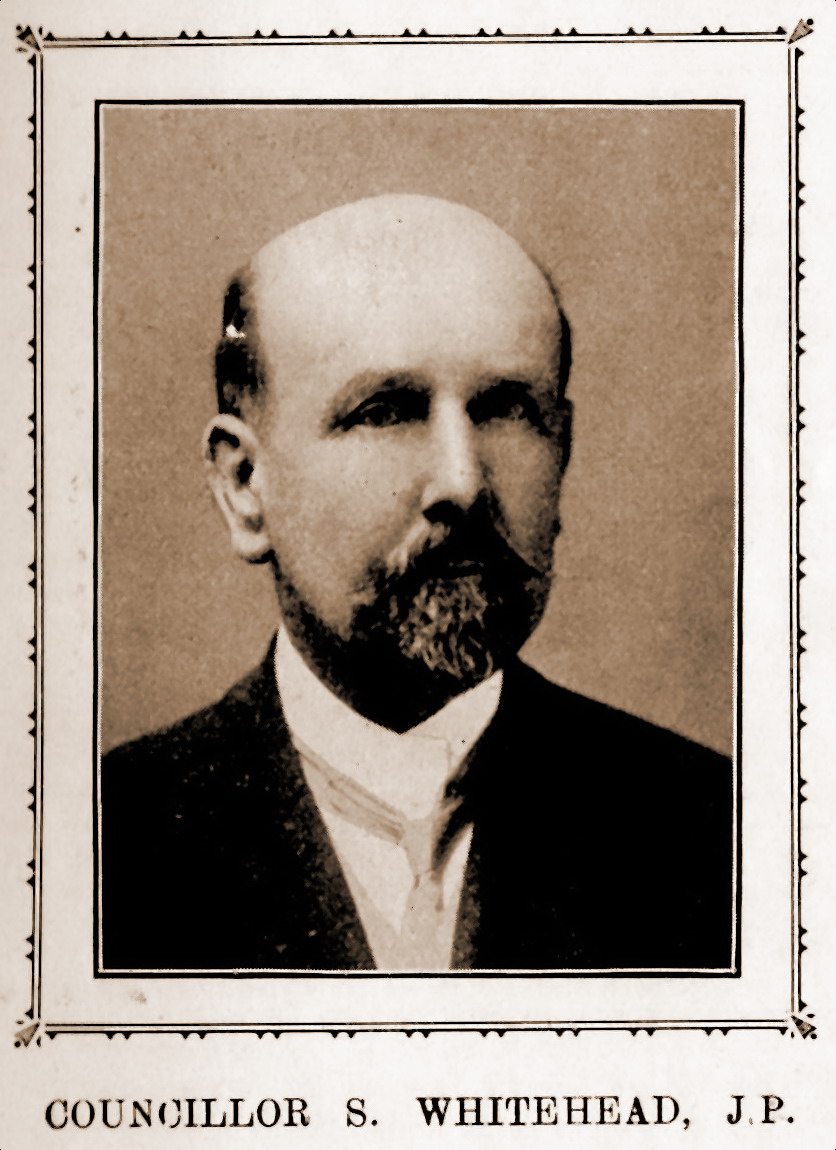 Although Mr. Samuel Whitehead's life as what is generally termed " a public man. '' is covered by the last five years, there is no man in New Mills better known for he has been very much of a public man in this town for more than forty years. Although Mr. Samuel Whitehead's life as what is generally termed " a public man. '' is covered by the last five years, there is no man in New Mills better known for he has been very much of a public man in this town for more than forty years.
Born at Denton, he was the son of Mr. William Whitehead, and belongs to a very old family in that well known centre of the hatting trade. When a boy he became a pupil teacher in Christ Church Schools, Denton, and after serving his time there be assisted for one year in the New Mills National Schools-the old school that was pulled down when the railway was made to Hayfield-his brother, Mr. James Whitehead, being the headmaster at that time. He then entered on his training at Durham College, and on its completion was appointed headmaster of the New Mills Schools, on the resignation of his brother in the year 1866. Few there are who have had such a long and successful career at one school, and no wonder that his old pupils are to be found in all parts of the globe, many holding prominent positions in various spheres, and not a few being successful business men. It is a noteworthy fact that the first Pupil Teacher he had in the School is now one of His Majesty's inspectors of Schools in Yorkshire, Mr. George Thorpe.
Mr. Whitehead has always " stuck to his last '' and he is universally respected in the district. During his mastership the present schools have been built and enlarged, and he has seen three Vicars. Rev. John Rigg, Rev. F. W. Newman, and Rev. J. L. Knowles. He is an old member of the Peveril of the Peak Lodge of Freemasons, but his public work commenced in April, 1903, when he had been elected a member of the Urban District Council for Beard and Ollersett Ward, and three years later he was returned unopposed. He is exofficio a member of all the Committees, but before the Chairman of the council was placed on all the Committees by virtue of his, office, Councillor Whitehead served on the Gas, Finance, Health, Water and other committees and is one of the most regular in his attendance. Last April he was honoured by his, colleagues with the chairmanship for the year, an office, which he fills with ability and credit. During his year of office he is, of course, an exofficio Justice of the Peace.
MR. HENRY TURNER. circa 1909.
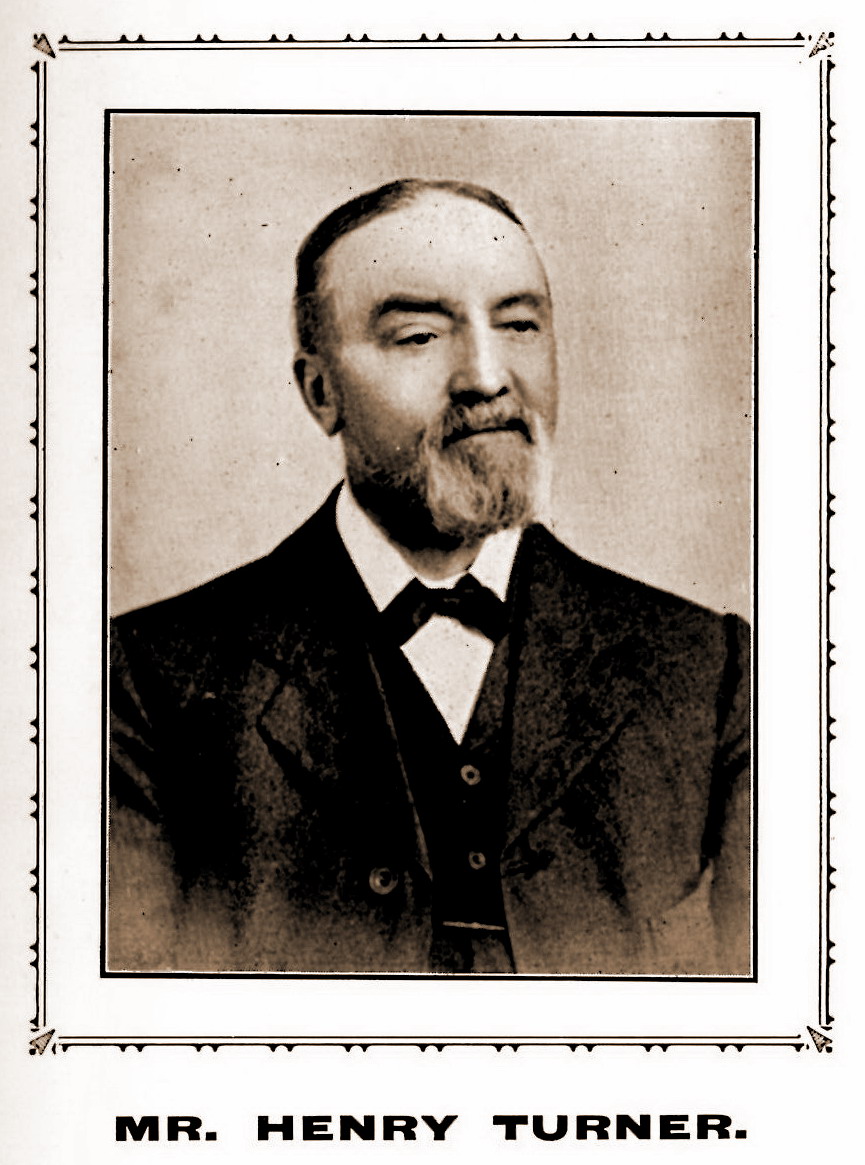 Mr Turner is the General Manager of the New Mills Co-operative Society, and although he has never sought office on any of the public bodies, there is no man more widely known and esteemed, for many miles around, as he has spent the whole of his long life in Hayfield, Mellor and New Mills. Mr Turner is the General Manager of the New Mills Co-operative Society, and although he has never sought office on any of the public bodies, there is no man more widely known and esteemed, for many miles around, as he has spent the whole of his long life in Hayfield, Mellor and New Mills.
He was born in Hayfield in the year 1839, and he spent the earlier years of his life in that place. While he was there he was connected with the Walk Mill Sunday School, and the connection then established remained unbroken to the present day.
When he was a young man he removed to Mellor, in the 1865, to take up the management of a small Co-operative Society in the village, and remained there for four years. He also identified himself with the New House Hill Sunday School, and here again he established a life-long connection.
A vacancy arose in connection with the New Mills Co-operative Society, and Mr Turner was appointed as Manager in August, 1869. Things were not then, what they are today, and the Society could not wield the influence and the power that it does today, but after being Manager for nearly forty years he has seen the Society develop from a weak effort to a strong mighty force. On his arrival in New Mills, Mr Turner again identified himself with the Free Church, and has lived a very strenuous life in New Mills, divided only between the Church, the School, and his daily occupation.
During a period of 45 years he has been a Local Preacher, Sunday School Teacher, and Superintendent, and it seems a fitness of things, that he should be so signally honoured by both his church and his employers in distinction of having his name inscribed on both sides of Spring Bank, for he laid one of the corner stones in connection with his own new church, and also one of the corner stones in the new central premises belonging to the Co-operative Society. Mr Turner’s health has been somewhat indifferent of late years, on several occasions having caused great anxiety to his friends, and for this reason his employers have given him some assistance in the discharge of his duties. He still retains his position of Manager of the Co-operative Society, and is proud to have been so long and honourably connected with a Society, which has done so much for the development of the town.
COUNCILLOR H. H. BULLOUGH. circa 1910.
Manager at Torr Vale Mills, owned by Mr. W. S. Lowe.
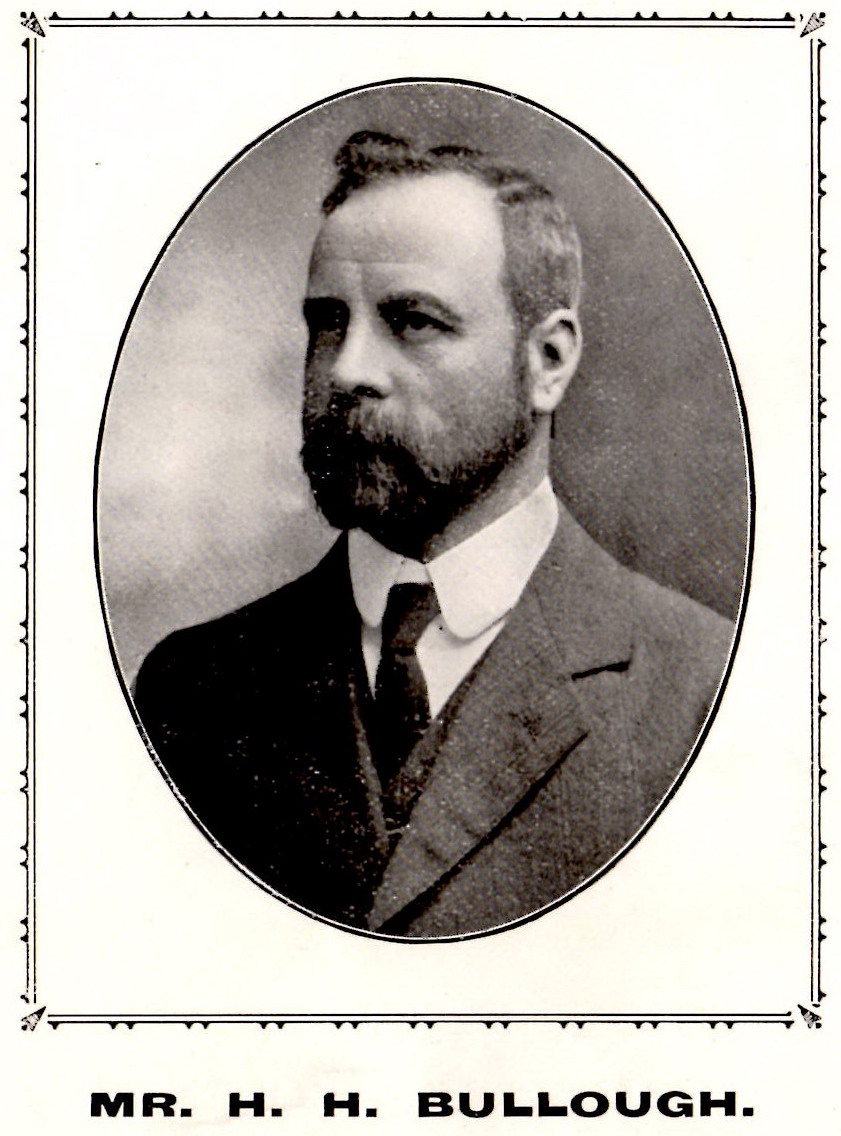 Born in Bolton, Lancashire, Mr Bullough spent over a quarter of a century in that town. Before he came to New Mills in 1892, he was Manager for Messrs. Rylands & Sons, at their Bolton mill, where he commenced as a half-timer. He left that situation to take up the position he still holds in New Mills. Whilst in Bolton he was connected with the Fletcher Street Wesleyan Sunday School, being Secretary of the Young Men’s Class at the time of his removal. Born in Bolton, Lancashire, Mr Bullough spent over a quarter of a century in that town. Before he came to New Mills in 1892, he was Manager for Messrs. Rylands & Sons, at their Bolton mill, where he commenced as a half-timer. He left that situation to take up the position he still holds in New Mills. Whilst in Bolton he was connected with the Fletcher Street Wesleyan Sunday School, being Secretary of the Young Men’s Class at the time of his removal.
On coming to New Mills, he joined the Wesleyans at Newtown. The Scheme for the New School was set n foot in 1897, and Mr Bullough was appointed Secretary of the Building Committee. The fine New School was built in 1903, but the debt not being entirely liquidated he is still Secretary of the Building Fund. He is also a Trustee.
Mr. Bullough was elected to the Urban District Council in 1907, and has been chairman since April last (1909). His term of office expires next March. Mr. Bullough is also a Governor of the Secondary School, a manager of the Council School, and a Member of the Higher Education Committee
MR. JOSEPH POLLITT. circa 1909.
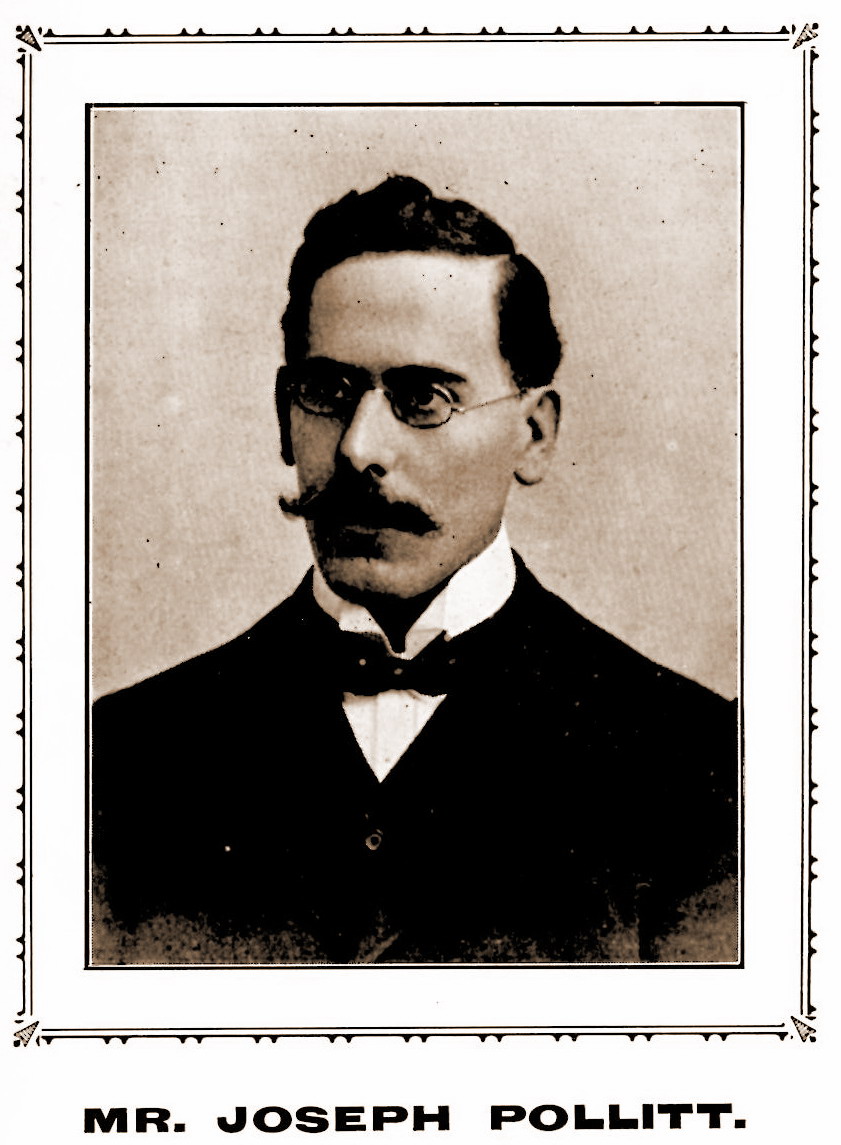 Born at New Mills, Mr. Joseph Pollitt is the second son of the late Mr. John Pollitt, who was one of the best known and most highly respected men in the north of Derbyshire. He received his appointment as Clerk to the Urban District Council of New Mills on the retirement of his father in the year 1894, having been Deputy-Clerk to the late Local Board for four years previous. Born at New Mills, Mr. Joseph Pollitt is the second son of the late Mr. John Pollitt, who was one of the best known and most highly respected men in the north of Derbyshire. He received his appointment as Clerk to the Urban District Council of New Mills on the retirement of his father in the year 1894, having been Deputy-Clerk to the late Local Board for four years previous.
During Mr. Pollitt's clerkship the responsibilities of the Council have considerably increased. A scheme of Sewerage and Sewage Disposal has been carried out, the High Peak Hospital has been erected at Chinley, the Town Hall was transferred to the Council and has been extended, and a Library built. The Council were successful in obtaining a Special Act of Parliament enabling them to acquire the Local Water Undertaking and for extended powers in connection with the Gas Undertaking. The Waterworks are now entirely in the hands of the Council, and the Gas Works have been practically re-modelled during the last few years. Mr. Pollitt has been a very diligent worker in connection with the Library Committee, he being the one to correspond with Dr. Carnegie, and finally got his consent to give a sum of £2,000 for the erection of a new Library.
Mr. Pollitt is a Congregationalist, is Financial Secretary in connection with that body, a position he has help for the last twenty years.
EDWARD GODWARD, ESQ, C.C. circa 1907
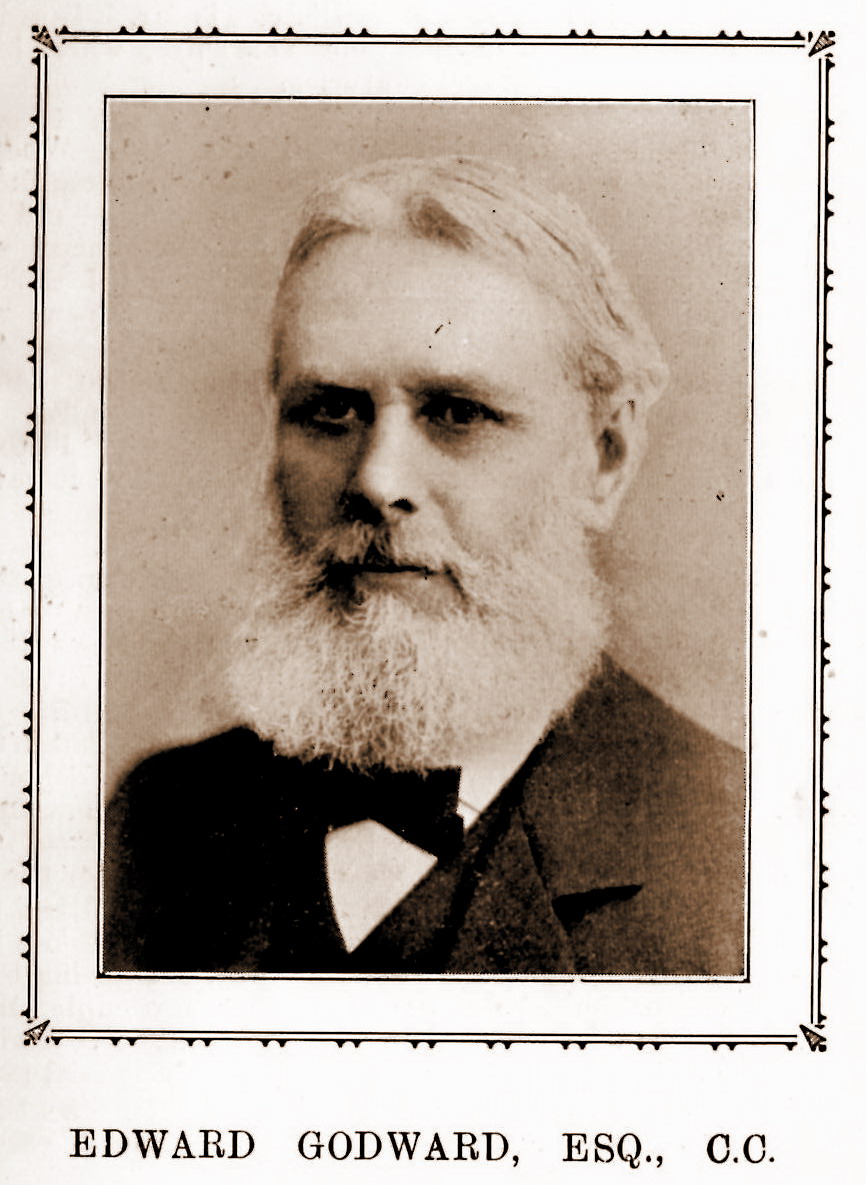 A prominent personage in the New Mills District is Mr. Edward Godward. A prominent personage in the New Mills District is Mr. Edward Godward.
C.C. His parents came from near Silkstone, Yorkshire, where his father's family occupied a small farm for several centuries.
Mr. Godward was born at Laneside New Mills, in 1841. When six years old he was for educational reasons sent to reside with an uncle in Yorkshire, a trained certificated Schoolmaster, then a rare personage, and received a good elementary training, and when ten years old commenced work in his father's band-walk.
About two years later he was enabled to continue his education in the evening consequent on New Mills Wesleyans engaging a young enthusiastic master from Westminster Training College. One Mr. Thomas Lawton, who was useful to many others. He was also privileged to receive valuable advice and educational assistance from Mr. John Taylor, of High Field, New Mills, who was a wise and kindly man. From the age of 16 to 21, Edward had much sickness and was kept from outdoor recreations, but it gave time him for thought.
When about 22 he became impressed by the condition of the working people, partly consequent on the cotton panic, he was drawn to agencies for their improvement, namely: Education, as Secretary of the News room; Total abstinence, as first Chairman of the Sons of Temperance Friendly Society in New Mills; Co-operation, as second Chairman of the New Mills Society, and an active member for 20 years. His Secretaryship of the Mechanic's Institute led to his appointment as Clerk and Attendance Officer to the School Board on its formation, which position he retained for 20 years, he is now Chairman of the Evening Classes Committee and the Secondary Day School Governors.
At the County Council Election in 1904, he was elected member for the New Mills District, He is a member of the County Education Committee, the Rating Committee and various Sub-committees. Succeeding to his father's business in 1868 he shortly afterwards purchased Brunswick Mill, but owing to ill health transferred the business to Limited Company in 1875, and occupied the position of managing director, meanwhile practising as an architect. Owing to the difficulty of securing efficient management of details of a special manufacture he returned to mill management in 1883, about a fortnight before the building was destroyed by fire. Its reconstruction and subsequent extension are sufficiently known.
Mr. Godward was a member of the Society of Friends and a staunch Liberal.
REV. JOSEPH YEARSLEY. circa 1907
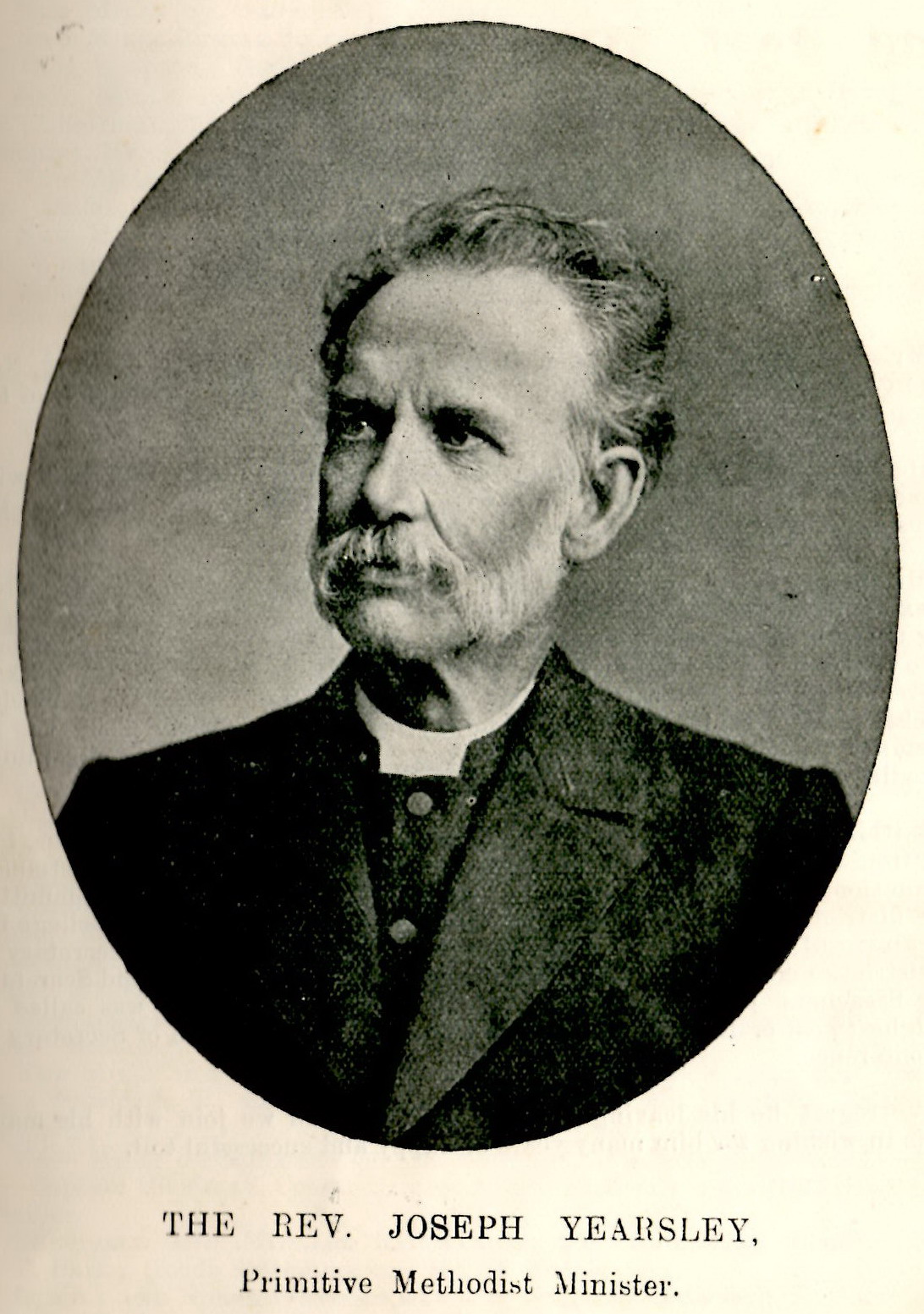 Mr. Yearsley, who has been in the ministry 36 years, is leaving New Mills In July, having accepted an invitation to take the Superintendency of the Glossop Circuit for the year 1907. Mr. Yearsley, who has been in the ministry 36 years, is leaving New Mills In July, having accepted an invitation to take the Superintendency of the Glossop Circuit for the year 1907.
He has resided with us for five years, and when he retires will carry with him, not only the enthusiastic good wishes of his own people, but of all the various sections of the Churches within the District.
Mr. Yearsley, has spent the whole of his ministry within what is known connexionally as the Manchester District, and enjoys the unique distinction of being the only Minister of his years of service who has not crossed the boundary line to take service within any of the other 26 Districts into which the work of this great religious organisation is divided. Within all the Primitive Methodist Churches in Lancashire he is well known, having had charge of most of its important Stations. During the past thirty years his ministry has been confined to a radius or not more than twelve miles from Manchester.
Within the denomination he occupies a most distinguished status, for, apart from his circuit work he has taken charge of several special departments of connexional work. For 16 years he was Secretary of the Building Committee of the district. He has also been the Secretary of the Connexional College for the training of the Ministers of his Church. At present he is the Secretary of the District Committee, the Examiner of Ministerial Probationers, and Secretary of the Preachers Friendly Society. At the last Conference be was called to the biggest post of distinction, by being elevated to the position of Secretary of the Conference.
We regret be his leaving our own District, and we join with his many friends in wishing for him many years of happy and successful toil.
REVEREND. W. D. EDMONDSON. circa 1908.
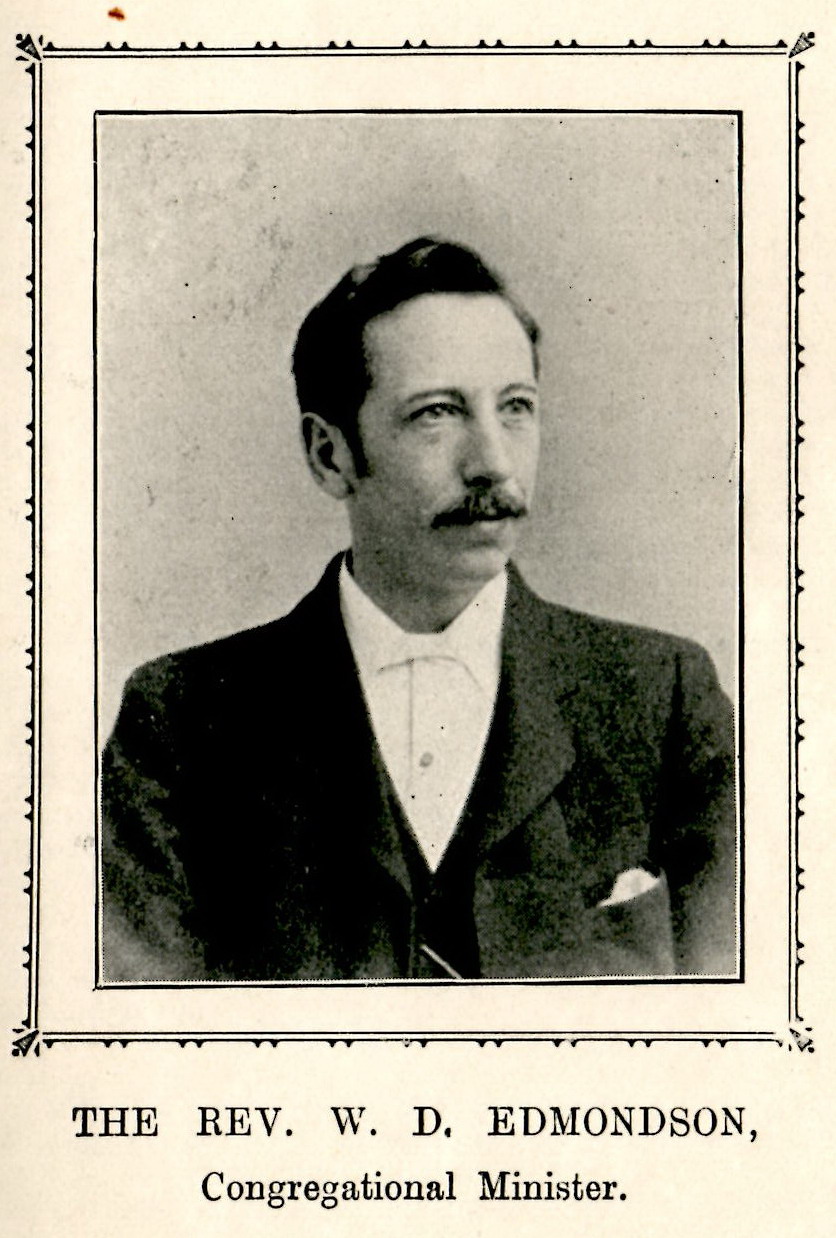 Mr. Edmondson was born in 1866 at Stockton-on-Tees, of Scotch parentage a Lowlander on the father’s side, and of Highland extraction on the mother’s side, who was a Sinclair of the Western Isles. He received his early educational training in Glasgow, whither his parents had removed, was a winner of the McLeod bursary in Geometrical Drawing and obtained distinction in Mathematics. His parents intention to send their son to a University was frustrated by an unforeseen calamity that visited many well-to-do families in Glasgow at that time, for the failure of the City of Glasgow Bank fleeced the Edmondson family of all they had, and they removed to Manchester where young Edmondson obtained a situation, applied himself to his studies, identified himself with Cavendish Chapel and School, and took parting Band of Hope City Mission work. Mr. Edmondson was born in 1866 at Stockton-on-Tees, of Scotch parentage a Lowlander on the father’s side, and of Highland extraction on the mother’s side, who was a Sinclair of the Western Isles. He received his early educational training in Glasgow, whither his parents had removed, was a winner of the McLeod bursary in Geometrical Drawing and obtained distinction in Mathematics. His parents intention to send their son to a University was frustrated by an unforeseen calamity that visited many well-to-do families in Glasgow at that time, for the failure of the City of Glasgow Bank fleeced the Edmondson family of all they had, and they removed to Manchester where young Edmondson obtained a situation, applied himself to his studies, identified himself with Cavendish Chapel and School, and took parting Band of Hope City Mission work.
In 1886, having completed successfully his Arts Course at Owens College, he took a three year Divinity course under the Rev, Paton at the Nottingham Congregational Institute; became assistant to Rev. Dr. Hodgson in the work of Knott Mill Hall where he was one of the foremost pioneers. In 1890, he became Pastor Evangelist of the Congregational Churches at Silverdale and Hollinsend, Staffordshire, in succession to Rev. J. H. Partridge (now of Charlesworth), when he was the recipient of valuable illuminated addresses and testimonials from the Cavendish Ragged School and the Knott Mill Mission.
For four years, he effected structural improvements and built up a strong cause, and in July 1894, Mr. Edmondson received a call and accepted the pastorate of the Providence Chapel, New Mills, and in the October following commenced his ministry, and was married in the following year. Mr. and Mrs. Edmondson have both toiled assiduously for the well being of “Providence.” From year to year there has been marked progress in all their undertakings. A few years ago the Chapel was altered and completely beautified with a new organ. Twelve months ago a spacious New School was opened, which after expending £1100, leaves a deficit of £300, which amount is loaned free of interest for two years. Thornsett Chapel has also been structurally improved and beautified. Mr. and Mrs. Edmondson enjoy the confidence of the congregation and they hold a warm place in their hearts.
Mr. Edmondson has served as a member of the Executive on the Derbyshire Congregational Union. He was the first Honorary Secretary of the New Mills Free Church Council, and afterwards served as President. He has also been a member of the New Mills School Board and the Hayfield Board of Guardians, and a member of the Free Libraries Committee, President of the New Mills and District Band of Hope Union, and President of the New Mills Social Reform Institute.
THE REV. J. LIONEL KNOWLES, M.A. circa 1907.
.jpg) Vicar of New Mills. Vicar of New Mills.
The Rev. J. Lionel Knowles, M.A., R.D., the Vicar of New Mills, had the advantage of being well known in the neighbouring parish of Glossop, long before he was appointed to this living.
He is the eldest son of the late Rev. John Dickenson Knowles, M.A., who was Vicar of Glossop for 23 years. He was born at Rawden, near Leeds, a seat of the woollen manufacture, and educated at Denstone College and Manchester Grammar School, from whence he proceeded to Pembroke College, Cambridge taking the B.A. Degree in 1884, and M.A. Degree in 1889. He was ordained Deacon, in December, 1885. by the present Bishop of Ripen, and took Priest's orders in 1887.
His first Curacy was at Ingrow-cum-Hainsworth, where he commenced and carried on a mission Church at Cross Roads. His other Curacies were Newton Moor. 1889 to 1893, St. Stephen's. Flowery Field, 1893 to 1894, Curate-in-charge of Scholes, in the Parish of Cleckheaton, Whitechapel-with-scholes, 1894 to 1900.
In 1900 he was preferred to the living of New Mills, on the resignation of the Rev. Frederick Wm. Newman, M.A., and was installed by the Bishop of Derby, on October 24th| of that year.
He was appointed Rural Dean of Glossop in 1906, in succession to the Rev. Joseph Hadfield, M.A., who had resigned, and in the same year was appointed a Surrogate for obtaining marriage licences.
REVEREND G. G. MARTINGDALE. circa 1910.
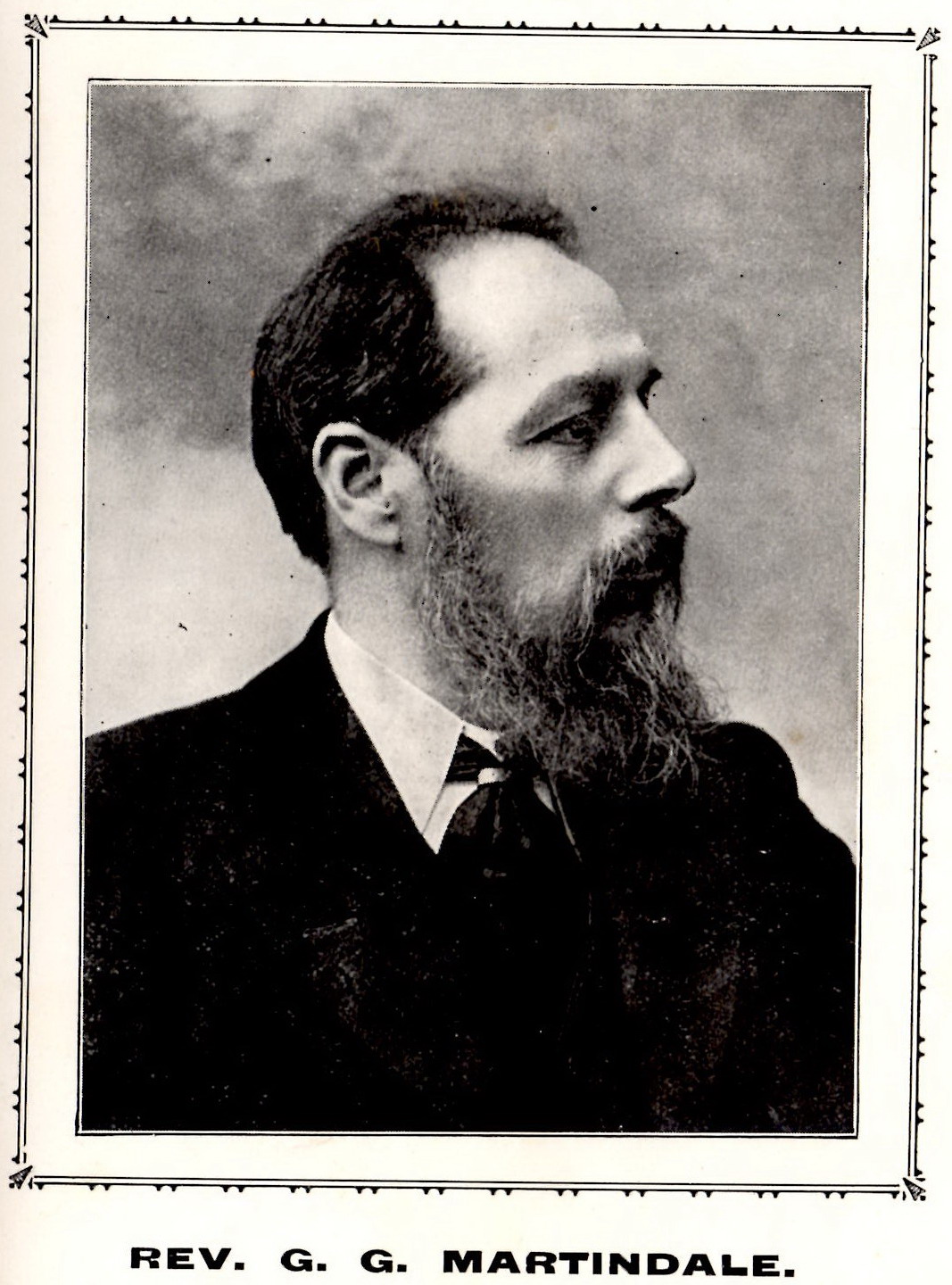 The Reverend George Gowthorp Martingdale was born in the Pocklington District, near Hull. He became a Local Preacher in connection with the Anlaby Road Circuit, Hull, and eventually in the Gainsborough Circuit, under the superintendency of the Rev. John Stephenson. After a period at College he was appointed to the Sheffield First Circuit. This was nearly thirty years ago, and except for a term at Scarborough and in this town, the whole has been spent within the borders of the Nottingham District, and much of it in the great industrial centres. The Reverend George Gowthorp Martingdale was born in the Pocklington District, near Hull. He became a Local Preacher in connection with the Anlaby Road Circuit, Hull, and eventually in the Gainsborough Circuit, under the superintendency of the Rev. John Stephenson. After a period at College he was appointed to the Sheffield First Circuit. This was nearly thirty years ago, and except for a term at Scarborough and in this town, the whole has been spent within the borders of the Nottingham District, and much of it in the great industrial centres.
In 1891, Mr Martingale was asked by the General Missionary Committee to undertake the superintendency of the Santa Isabel Station, Fernando Po, West Africa; but owing to domestic circumstances he was unable to go.
The sound and faithful work that he has done has evidenced itself in the advancement of his Stations, the appreciation of his officials, and the affections of his people.
For nine years he has been the Arrangement Secretary of the Holiday Tours Committee, and during that period it has fallen to his lot to organise Holiday Tours in the Homeland, and also in Switzerland.
He came to the New Mills Circuit in July, 1907, and has made many friends, both amongst his own people and those attending other churches.
COUNCILLOR SETH EVANS. J.P. 1925.
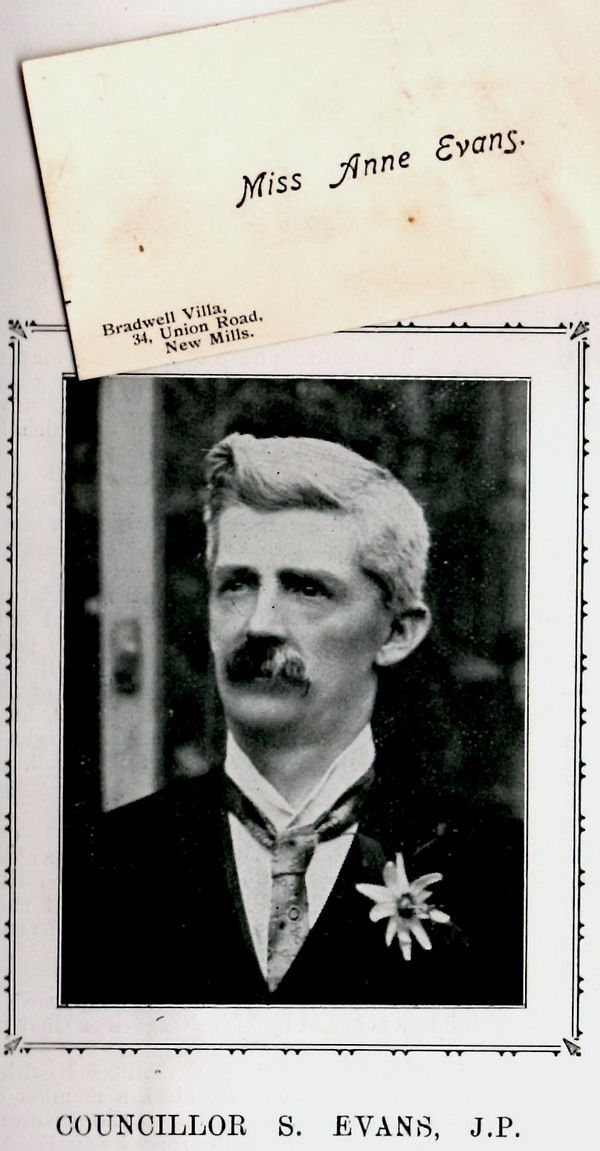 Councillor Seth Evans, J.P., who presided over the New Mills Urban District Council, was well known to most people throughout the High Peak where from boyhood he had followed his profession as a journalist. Councillor Seth Evans, J.P., who presided over the New Mills Urban District Council, was well known to most people throughout the High Peak where from boyhood he had followed his profession as a journalist.
Seth was born in June 1858, and raised in Bradwell where his ancestors have been local Lead miners for centuries past. He was put to work in the family business at eight years old, and received only such a smattering of the rudiments of elementary education. Lead mining was a declining industry and Seth sought other work elsewhere, finding it first in a cotton mill at Bamford, where he became an overseer. Whilst there he made extensive use of night classes to further his education. He must have been a good pupil, because by the age of sixteen he had become a part-time journalist with the High Peak Advertiser, covering events in his native town and the Hope Valley. Shortly after he opened a newsagents shop in Water Street, Bradwell.
Seth was to marry four times, the first marriage, at the age of 18, was to Sarah Anne Elliot, of Smalldale in November 1877. At the age of 24, Seth accepted an offer of a full time position representative of the High Peak Advertiser in New Mills, though he also retained his representation of the Hope Valley. He moved to New Mills and set up a newsagents and stationer on Market Street, whilst covering the news of the day.
Tragedy struck on the 29th of March, when Sarah his wife died ‘after a long and painful affliction’ after 12 years of marriage. Seth was left with a daughter named Anne.
Seth was married again in June 1890, to Elizabeth Hannah, and had a son Stephen. Elizabeth was struck down with tuberculosis and passed away on the 22nd of January 1893, aged 29. Seth married his third wife Mary, in June 1895. They lived at 34 Union Road one of a pair of houses on Union Road built by Seth and called Bradwell Villas, the houses still stand today at the top of the Union Bridge. Mary died on the 1st of August 1904, at the age of 42. Seth was married a fourth time by a wife who survived him.
He was a most prolific writer on matters and things pertaining to the past and present of the Peak district, was well versed in local history, and never tired of singing (with his pen of course) the praises of his native Peakland. He was a, member of the Derbyshire Archeological and Natural History Society. He had a thorough knowledge of every nook and corner of the district as well as of the people and their doings.
Seth did much research into Church and Chapel records producing books titled New Mills Wesleyanism, 1912,and Methodism in Bradwell, 1907, both valuable books for the local historian. He wrote ‘Bradwell Lead Mining Customs’ published in the Derbyshire Archaeological Journal, of 1911. Published Bradwell Ancient and Modern and Peakland Pickings, 1915. Plus of course, 50 years of news reporting.
Seth was a life long Liberal in politics and in religion a staunch Wesleyan Methodist, as reflected by his books. In his early years he was an active preacher and had occupied the pulpit at all the Methodist churches in the Peak circuit.
For eight years he sat on the Bradwell School Board, and at the last contested election was returned at the head of the poll, and when that body was dissolved by the education Act of 1902, he had accomplished the unique feat of never having been absent once in eight years. He became quite a wealthy man, he owned two houses, and in addition to his newsagents he owned a printing business, The Kinder Press, and had built a number of houses in Bradwell.
He retained his membership of the School Council at Bradwell and was Vice-chairman and later chairman. Though he lived for many years in New Mills, Seth always retained a great love of Bradwell and the Hope Valley; it remained always his spiritual home.
In New Mills, at the last contested election of School Board he was elected, and at the first meeting of the Board was chosen Vice-chairman and later Chairman. He was the Vice-chairman of the schools Council before becoming Chairman. He was also a governor of the Secondary Schools and Pupil Teachers Centre, and a member of the Evening Classes Committee.
In 1903, he was returned to the District Council unopposed, and on his re-election in March 1906, he was elected by his colleagues as Chairman.
He was a member of the Gas Committee, Finance Committee and Health Committee, Seth was one of the Governors of the High Peak Hospital, a member of the Free Libraries Committee, and represents the Council on the governing body of the Secondary Schools. Having been elected Chairman he qualified as a Justice of the Peace, and sat at New Mills and Chapel-en-le-Frith. For Seth this was the crowning point of his career
He also had the distinction of presiding over the Council's deliberations during the year in which the Water and Gas Bill went through Parliament, and the Water-works taken over.
Seth Evans died on the 6th of January 1925, aged 66. On the day of his death, he had visited Bradwell and the Hope Valley to gather information about a man who had gone missing. On his return, home he collapsed and died. Apparently, he had suffered from a heart complaint for a number of years. It was suggested that Seth might not have been displeased to have spent the first and last days of his journalistic life in Bradwell.
His funeral cortege journeyed slowly around the packed streets of New Mills, followed and silently observed by hundreds of mourners. The coffin was conveyed to Central Station and loaded aboard the train to Hope, from where it was conveyed with due reverence to the Wesleyan Chapel at Bradwell. There it was met by the Reverend W.H. Mason, and a huge crowd of mourners. After a service, Seth was laid to rest with his first three wives in their joint grave, beneath the trees of the Chapel yard.
During the eulogy Rev. Mason said of Seth:
“If one word only were to be used to describe his life, it would be
‘Industry.’ He was a worker; he was a toilsome man. He began
life with a shovel in a mine, but early changed his tool for the
pen, and for many years he wielded the pen of a ready writer.”
The editor of the Reporter wrote in that paper an obituary of Seth Evans. It tells much of the dedication of the man and the high regard and great respect in which he was held:
“His life for half a century had been of the most strenuous and exacting nature, making tremendous demands on his nervous energy. One often wondered how he accomplished so much, until one accidentally learned at the end of busy day that he was up till four o’clock that morning writing out his copy, so that he might fulfil some public engagement. His courage was abundant, for he had faced on foot for many years his journeys through the Hope Valley and the Derwent Valley, on bleak and raw days such as Tuesday was, often in the teeth of a Peak blizzard and knee deep in snow. Those who had been intimately aquainted with him did not wonder that he was prematurely aged. Only last month, after a long and exacting day in journalistic work, he arrived at a New Mills Council meeting almost exhausted, but stayed to the end of important and special business. New mills has lost a public man whose place will be extremely difficult to fill, for he was a guide, philosopher and friend to many people even to the extent of consenting to be their executor when dead. He will be greatly missed and by none more than his journalistic colleagues, to whom he was ever ready to extend the helping hand, and to give from his unrivalled local knowledge and experience all they desired.
Mr. Evans leaves a widow, son and daughter, for whom much sympathy is needed in their great sorrow. Miss Evans is the librarian at New Mills Free Library.
As is the custom the Town Hall flag at New Mills was hoisted to half-mast as a mark of respect.
Memorial Inscriptions at Bradwell.
Awaiting Christ’s return in glory the body of his handmaid SARAH ANN
the beloved and devoted wife of SETH EVANS, of this place who after a long
and painful affliction fell asleep in Jesus March 24th 1889 aged 31 years.
"Ye are walking still in the vale of tears, but I wait to welcome you."
ALSO, ELIZABETH HANNAH second wife of SETH EVANS died in the Lord,
January 22nd, 1893 in her 30th year.
Also MARY, the beloved wife of SETH EVANS died August 1st 1904 aged
42 years (May I be there). Also ANN daughter of SETH & SARAH EVANS
Died Sept. 17th 1942 aged 64 years at rest.
In memory of SETH EVANS J.P. died Jan 6th 1925 aged 66 years at rest.
He was a Justice of the Peace for this county for many years a member of
Bradwell School Board, New Mills School Board, New Mills Urban District
Council, Trustee of this Chapel. Author of Bradwell Ancient and Modern,
Methodism in Bradwell and other works.
FATHER JOSEPH HEALD. circa 1946.
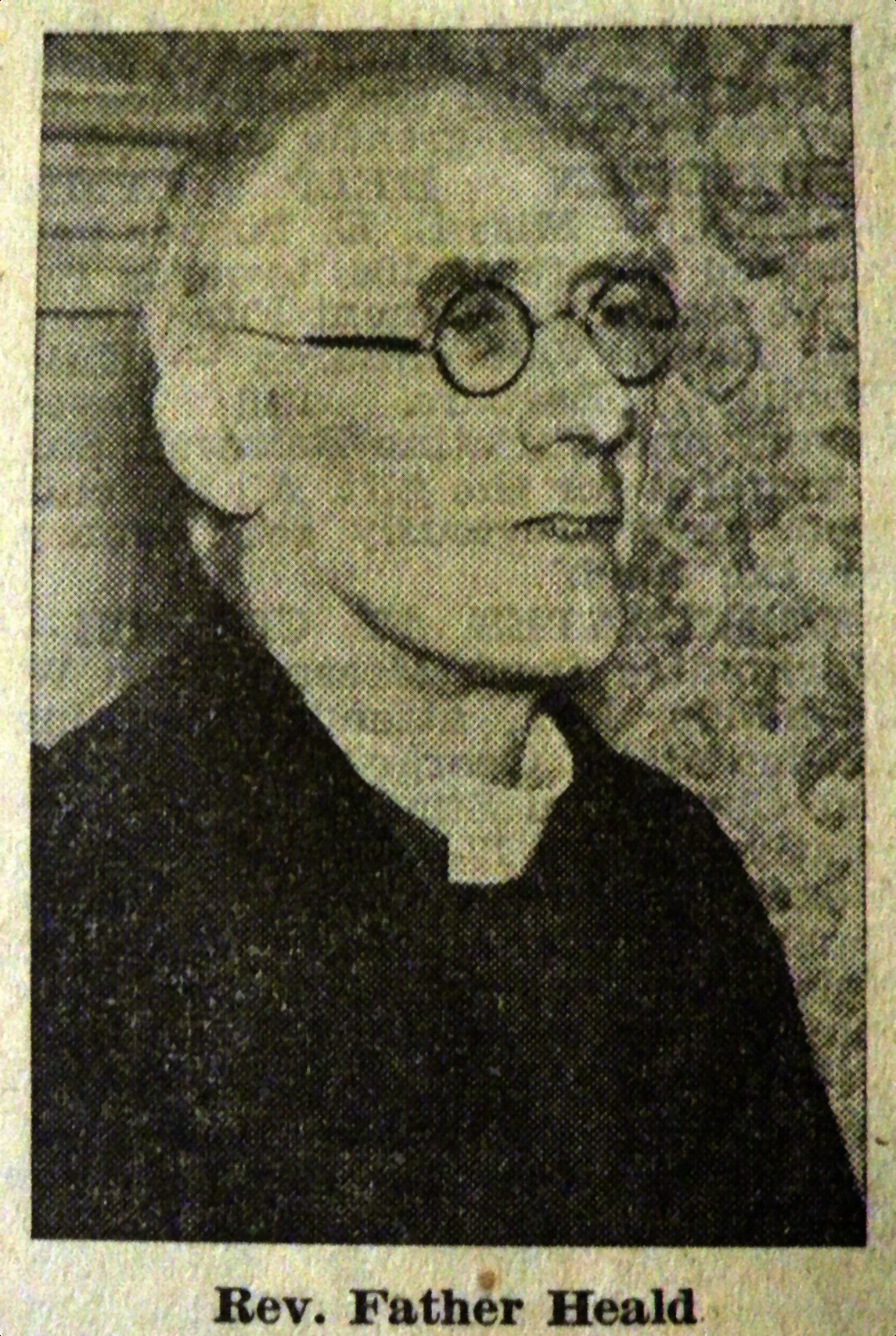 Father Heald attended his local grammar School as a boy and went on to Oxford University. He was a scholar of his college and took his M.A. degree. After a course at Cuddesdon Theological College, he was ordained deacon and then priest in the Church of England. His first curacy was at Newbold, near Chesterfield. Later he served in Birmingham and also in the East End of London. Father Heald attended his local grammar School as a boy and went on to Oxford University. He was a scholar of his college and took his M.A. degree. After a course at Cuddesdon Theological College, he was ordained deacon and then priest in the Church of England. His first curacy was at Newbold, near Chesterfield. Later he served in Birmingham and also in the East End of London.
At the end of the 1914-18 war, he was received into the Catholic Church in London and trained for the priesthood at Ware and in Rome. At Nottingham, he was ordained priest and was appointed to Alfreton in Derbyshire. He came to New Mills in 1929 and at once fell in love with the beautiful little church. Father Heald was a gifted artist, and to restore the church was a work after his own heart. He also built a Lourdes shrine near the church, which can still be seen today.
1946 saw a Thanksgiving Mass at St. Mary’s Catholic Church in celebration of the silver jubilee of Father Heald attaining the priesthood. Later that evening practically the whole membership of the church attended a gathering at the Trades Hall.
MR. JAMES GARSIDE. February 1952.
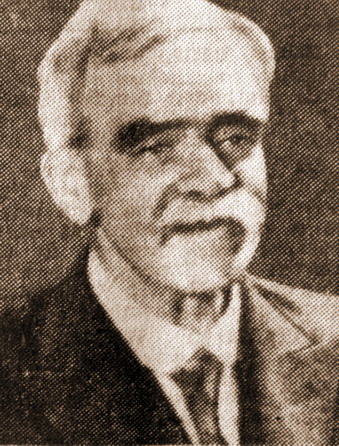 Aged 76, and a native of the village, Mr. Garside was the younger son of the late Mr. And Mrs. Luke Garside, and on his fathers side he belonged to an old Mottram family, which came to Hayfield well over a century ago. In his younger days he was employed at Kinder Printworks and also at Hayfield Printworks. On the death of his father, he succeeded to the newsagency business in Church Street, which he carried on until he transferred it to his nephew, Mr. Sam Garside, three years ago. He had also established an extensive business in the Birch Vale and Thornsett district, but was compelled to dispose of it when his nephew joined the army. Aged 76, and a native of the village, Mr. Garside was the younger son of the late Mr. And Mrs. Luke Garside, and on his fathers side he belonged to an old Mottram family, which came to Hayfield well over a century ago. In his younger days he was employed at Kinder Printworks and also at Hayfield Printworks. On the death of his father, he succeeded to the newsagency business in Church Street, which he carried on until he transferred it to his nephew, Mr. Sam Garside, three years ago. He had also established an extensive business in the Birch Vale and Thornsett district, but was compelled to dispose of it when his nephew joined the army.
As a boy of nine, Mr. Garside began to carry papers to Little Hayfield for his father and after he retired from business he continued that round for old associations sake until about 18 months ago. Altogether he distributed there for about 64 or 65 years.
Over hill and dale Mr. Garside tramped thousands of miles with loads of papers of all sorts and never had the help of any vehicle, even a bicycle. He was a great walker and for many years he went regularly over Kinder Scout to attend the famous Woodlands Love Feast. At the age of 75 he did this walk last year. For a long period Mr. Garside also walked to Eyam to attend the Plague Service.
In his business Mr. Garside's great ideal was service to his customers and no tradesman was ever more faithful. His holidays were very few indeed. During the great storm of 1941 when neither trains nor buses could get to Hayfield. Mr. Garside tramped three miles to New Mills station to collect his newspaper parcels and distributed hundred of papers.
The late Mr. Luke Garside was an antiquarian and historian of wide repute and he had assembled a considerable library on these subjects. His son inherited his tastes and his books and himself perused the same studies. He had added extensively to his library, which became one of the finest local libraries in the High Peak.
He wrote many articles on Peak history for the Reporter and other journals. His knowledge of Hayfield in particular was unrivalled and he was the recognised authority in village history who was often appealed to and as often responded.
There were occasions when Mr. Garside's researches into Hayfield history were of signal service to the parish and two may be mentioned. In the 1930's there were several floods, one of which did much damage to Valley Road. The County Council, who had become the highway authority, denied that the road was repairable by the inhabitants at large and said it was the liability of the property owners Mr. Garside produced a document which showed the road had been repaired by the surveyors of highways who were the road authority long before there were any councils. The document was accepted by the County Council who repaired the road.
A flood in 1944 washed up Clough Lane at Little Hayfield. Again the County Council denied that it was a highway repairable by the public and said it was the liability of property owners. Mr. Garside produced the account book of the surveyors of highways, which showed that the surveyors had repaired Clough Lane in the 1820s. The County Council accepted the evidence and repaired the lane.
Mr. Garside was one of the last to hold the ancient office of overseer of the poor before it was abolished, but although he had been rendering public service unofficially for about 50 years, it was not until 1946 that he sought a seat on Hayfield Parish Council. He was elected at the top of the poll. By that time there was adult suffrage for the election of local councils and Mr. Garside received the highest number of votes given to a candidate at Hayfield.
At the first meeting of the council Mr. Garside was elected vice-chairman. It was the custom of the council to appoint the vice-chairman the chairman in the following year and Mr. Garside had expected the custom to be followed. For him 1947 was to be a red-letter year. He had taken part in the agitation to get the footpath over Kinder Scout to the Snake Inn and had led parties over the route before the footpath was dedicated in 1897. The Peak district and Northern Footpaths Preservation Society decided to celebrate the jubilee of the opening of the footpath at Hayfield and asked Mr. Garside to be one of the principle speakers. He had also arranged an exhibition of photographs, cartoons and literature of various kinds relating to the footpath.
To be “Mayor” of his native village on this memorable occasion was an honour Mr. Garside was looking forward to with real pleasure and pride and he had made tentative arrangements for his “Churching” at the Bethel Methodist Chapel. But to his own astonishment and that of the whole village, the Parish Council did not appoint Mr. Garside to the chair. This unkind cut deeply hurt Mr. Garside after his long service and the numerous occasions on which he had helped Hayfield Parish Council. He took part in the jubilee celebrations and staged his exhibition, which earned warm praise. But his interest in Parish Council work waned, and when his term of office expired he did not seek re-election to the council.
For generations the Garside family has been associated with the Bethel Methodist Church. Mr. James Garside was Sunday school secretary for over 50 consecutive years, retiring several years ago when he was presented with book tokens in appreciation of his long services. He was a member of the Old Age Pensioners Association and enjoyed their meetings, and maintained an interest in the Liberal Association. A good mathematician, Mr. Garside took an interest in the Co-operative Holiday Association and was connect with the Literary Society, which used to be in existence in Hayfield. He was connected with the Field Naturalist Society and was a friend of Mr. G. B. Ward, the well-known rambler and writer of Sheffield.
To the last his native hills and the old customs called Mr. Garside Even in the stormy weather of the days before his death, he was to be seen coming from the Old Pits Plantation where the public had rights, carrying a few sticks for fire lighting. Hayfield will not see his like again and no other will love his native village more or seek to defend its rights and privileges with more precise, knowledge and courage. Hayfield will not know another of his rugged character, or one more faithful to his ideals of service as a tradesman, or to any organization to which he was a member. He was one of Hayfield’s more distinguished sons.
 |







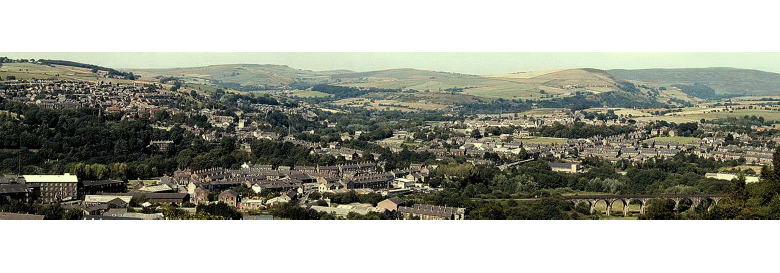

 Although Mr. Samuel Whitehead's life as what is generally termed " a public man. '' is covered by the last five years, there is no man in New Mills better known for he has been very much of a public man in this town for more than forty years.
Although Mr. Samuel Whitehead's life as what is generally termed " a public man. '' is covered by the last five years, there is no man in New Mills better known for he has been very much of a public man in this town for more than forty years. Mr Turner is the General Manager of the New Mills Co-operative Society, and although he has never sought office on any of the public bodies, there is no man more widely known and esteemed, for many miles around, as he has spent the whole of his long life in Hayfield, Mellor and New Mills.
Mr Turner is the General Manager of the New Mills Co-operative Society, and although he has never sought office on any of the public bodies, there is no man more widely known and esteemed, for many miles around, as he has spent the whole of his long life in Hayfield, Mellor and New Mills. Born in Bolton, Lancashire, Mr Bullough spent over a quarter of a century in that town. Before he came to New Mills in 1892, he was Manager for Messrs. Rylands & Sons, at their Bolton mill, where he commenced as a half-timer. He left that situation to take up the position he still holds in New Mills. Whilst in Bolton he was connected with the Fletcher Street Wesleyan Sunday School, being Secretary of the Young Men’s Class at the time of his removal.
Born in Bolton, Lancashire, Mr Bullough spent over a quarter of a century in that town. Before he came to New Mills in 1892, he was Manager for Messrs. Rylands & Sons, at their Bolton mill, where he commenced as a half-timer. He left that situation to take up the position he still holds in New Mills. Whilst in Bolton he was connected with the Fletcher Street Wesleyan Sunday School, being Secretary of the Young Men’s Class at the time of his removal. Born at New Mills, Mr. Joseph Pollitt is the second son of the late Mr. John Pollitt, who was one of the best known and most highly respected men in the north of Derbyshire. He received his appointment as Clerk to the Urban District Council of New Mills on the retirement of his father in the year 1894, having been Deputy-Clerk to the late Local Board for four years previous.
Born at New Mills, Mr. Joseph Pollitt is the second son of the late Mr. John Pollitt, who was one of the best known and most highly respected men in the north of Derbyshire. He received his appointment as Clerk to the Urban District Council of New Mills on the retirement of his father in the year 1894, having been Deputy-Clerk to the late Local Board for four years previous. A prominent personage in the New Mills District is Mr. Edward Godward.
A prominent personage in the New Mills District is Mr. Edward Godward. Mr. Yearsley, who has been in the ministry 36 years, is leaving New Mills In July, having accepted an invitation to take the Superintendency of the Glossop Circuit for the year 1907.
Mr. Yearsley, who has been in the ministry 36 years, is leaving New Mills In July, having accepted an invitation to take the Superintendency of the Glossop Circuit for the year 1907. Mr. Edmondson was born in 1866 at Stockton-on-Tees, of Scotch parentage a Lowlander on the father’s side, and of Highland extraction on the mother’s side, who was a Sinclair of the Western Isles. He received his early educational training in Glasgow, whither his parents had removed, was a winner of the McLeod bursary in Geometrical Drawing and obtained distinction in Mathematics. His parents intention to send their son to a University was frustrated by an unforeseen calamity that visited many well-to-do families in Glasgow at that time, for the failure of the City of Glasgow Bank fleeced the Edmondson family of all they had, and they removed to Manchester where young Edmondson obtained a situation, applied himself to his studies, identified himself with Cavendish Chapel and School, and took parting Band of Hope City Mission work.
Mr. Edmondson was born in 1866 at Stockton-on-Tees, of Scotch parentage a Lowlander on the father’s side, and of Highland extraction on the mother’s side, who was a Sinclair of the Western Isles. He received his early educational training in Glasgow, whither his parents had removed, was a winner of the McLeod bursary in Geometrical Drawing and obtained distinction in Mathematics. His parents intention to send their son to a University was frustrated by an unforeseen calamity that visited many well-to-do families in Glasgow at that time, for the failure of the City of Glasgow Bank fleeced the Edmondson family of all they had, and they removed to Manchester where young Edmondson obtained a situation, applied himself to his studies, identified himself with Cavendish Chapel and School, and took parting Band of Hope City Mission work..jpg) Vicar of New Mills.
Vicar of New Mills. The Reverend George Gowthorp Martingdale was born in the Pocklington District, near Hull. He became a Local Preacher in connection with the Anlaby Road Circuit, Hull, and eventually in the Gainsborough Circuit, under the superintendency of the Rev. John Stephenson. After a period at College he was appointed to the Sheffield First Circuit. This was nearly thirty years ago, and except for a term at Scarborough and in this town, the whole has been spent within the borders of the Nottingham District, and much of it in the great industrial centres.
The Reverend George Gowthorp Martingdale was born in the Pocklington District, near Hull. He became a Local Preacher in connection with the Anlaby Road Circuit, Hull, and eventually in the Gainsborough Circuit, under the superintendency of the Rev. John Stephenson. After a period at College he was appointed to the Sheffield First Circuit. This was nearly thirty years ago, and except for a term at Scarborough and in this town, the whole has been spent within the borders of the Nottingham District, and much of it in the great industrial centres. Councillor Seth Evans, J.P., who presided over the New Mills Urban District Council, was well known to most people throughout the High Peak where from boyhood he had followed his profession as a journalist.
Councillor Seth Evans, J.P., who presided over the New Mills Urban District Council, was well known to most people throughout the High Peak where from boyhood he had followed his profession as a journalist. Father Heald attended his local grammar School as a boy and went on to Oxford University. He was a scholar of his college and took his M.A. degree. After a course at Cuddesdon Theological College, he was ordained deacon and then priest in the Church of England. His first curacy was at Newbold, near Chesterfield. Later he served in Birmingham and also in the East End of London.
Father Heald attended his local grammar School as a boy and went on to Oxford University. He was a scholar of his college and took his M.A. degree. After a course at Cuddesdon Theological College, he was ordained deacon and then priest in the Church of England. His first curacy was at Newbold, near Chesterfield. Later he served in Birmingham and also in the East End of London. Aged 76, and a native of the village, Mr. Garside was the younger son of the late Mr. And Mrs. Luke Garside, and on his fathers side he belonged to an old Mottram family, which came to Hayfield well over a century ago. In his younger days he was employed at Kinder Printworks and also at Hayfield Printworks. On the death of his father, he succeeded to the newsagency business in Church Street, which he carried on until he transferred it to his nephew, Mr. Sam Garside, three years ago. He had also established an extensive business in the Birch Vale and Thornsett district, but was compelled to dispose of it when his nephew joined the army.
Aged 76, and a native of the village, Mr. Garside was the younger son of the late Mr. And Mrs. Luke Garside, and on his fathers side he belonged to an old Mottram family, which came to Hayfield well over a century ago. In his younger days he was employed at Kinder Printworks and also at Hayfield Printworks. On the death of his father, he succeeded to the newsagency business in Church Street, which he carried on until he transferred it to his nephew, Mr. Sam Garside, three years ago. He had also established an extensive business in the Birch Vale and Thornsett district, but was compelled to dispose of it when his nephew joined the army.